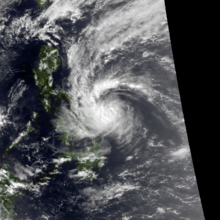
Back Bagyong Thelma BCL Thelma ekaitz tropikala Basque Tempête tropicale Thelma French Tempestade tropical Thelma Portuguese Tropical Storm Thelma SIMPLE Bagyong Uring Tagalog Bão Thelma (1991) Vietnamese 熱帶風暴黛瑪 (1991年) Chinese
 Thelma near peak intensity, approaching the Philippines on November 4 | |
| Meteorological history | |
|---|---|
| Formed | November 1, 1991 |
| Dissipated | November 8, 1991 |
| Tropical storm | |
| 10-minute sustained (JMA) | |
| Highest winds | 75 km/h (45 mph) |
| Lowest pressure | 992 hPa (mbar); 29.29 inHg |
| Tropical storm | |
| 1-minute sustained (SSHWS/JTWC) | |
| Highest winds | 85 km/h (50 mph) |
| Overall effects | |
| Fatalities | 5,081 – 8,165 total (4,922 in Ormoc) |
| Damage | $27.7 million (1991 USD) |
| Areas affected | |
| IBTrACS | |
Part of the 1991 Pacific typhoon season | |
Tropical Storm Thelma, known in the Philippines as Tropical Storm Uring, was one of the deadliest tropical cyclones in Philippine history, killing at least 5,081 people. Forming out of a tropical disturbance on November 1, 1991, several hundred kilometers north-northeast of Palau, the depression that would become Thelma tracked generally westward. After turning southwestward in response to a cold front, the system intensified into a tropical storm on November 4 as it approached the Philippines. Hours before moving over the Visayas, Thelma attained its peak intensity with estimated ten-minute sustained winds of 75 km/h (45 mph) and a barometric pressure of 992 mbar (hPa; 29.29 inHg). Despite moving over land, the system weakened only slightly, emerging over the South China Sea on November 6 while retaining gale-force winds. Thelma ultimately succumbed to wind shear and degraded to a tropical depression. On November 8, the depression made landfall in Southern Vietnam before dissipating hours later.
While passing over the Philippines, Thelma's interaction with the high terrain of some of the islands resulted in torrential rainfall. Through the process of orographic lift, much of the Visayas received 150 mm (6 in) of rain; however, on Leyte Island there was a localized downpour that brought totals to 580.5 mm (22.85 in). With the majority of this falling in a three-hour span, an unprecedented flash flood took place on the island. Much of the land had been deforestated or poorly cultivated and was unable to absorb most of the rain, creating a large runoff. This water overwhelmed the Anilao–Malbasag watershed and rushed downstream. Ormoc City, located past where the Anilao and Malbasag rivers converge, suffered the brunt of the flood. In just three hours, the city was devastated with thousands of homes damaged or destroyed. A total of 4,922 people were killed in the city alone, with 2,300 perishing along the riverbank.
Outside of Ormoc City, 159 people were killed across Leyte and Negros Occidental. Throughout the country, at least 5,081 people died while another 1,941–3,084 were missing and presumed dead. This made Thelma the deadliest tropical cyclone in Philippine history, surpassing a storm in 1867 that killed 1,800,[1][2] until later surpassed by Typhoon Haiyan (Yolanda) in 2013 which killed at least 6,300 people.[3] A total of 4,446 homes were destroyed while another 22,229 were damaged. Total losses amounted to $27.67 million.[nb 1] Initially, it took over 24 hours for word of the disaster to reach officials due to a crippled communication network around Ormoc City. Within a few days, emergency supply centers were established and aid from various agencies under the United Nations and several countries flowed into the country. A total of $5.8 million worth of grants and materials was provided collectively in the international relief effort.
- ^ Pedro Ribera, Ricardo Garcia-Herrera and Luis Gimeno (July 2008). "Historical deadly typhoons in the Philippines" (PDF). Weather. 63 (7): 196. Bibcode:2008Wthr...63..194R. doi:10.1002/wea.275. S2CID 122913766.
- ^ Dominic Alojado and Michael Padua (July 29, 2010). "The Twelve Worst Typhoons Of The Philippines (1947–2009)". Typhoon2000. Archived from the original on September 19, 2019. Retrieved May 6, 2013.
- ^ "Updates re Effects of Typhoo "Yolanda" (Haiyan)" (PDF). National Disaster Risk Reduction and Management Council. April 17, 2014. Archived from the original (PDF) on October 6, 2014. Retrieved April 17, 2014.
Cite error: There are <ref group=nb> tags on this page, but the references will not show without a {{reflist|group=nb}} template (see the help page).